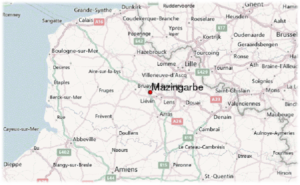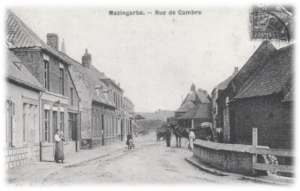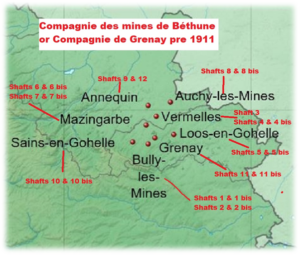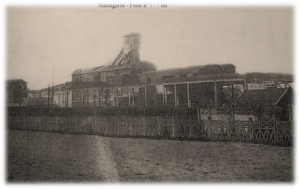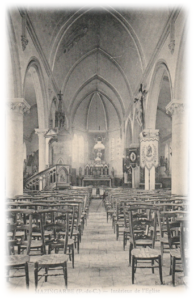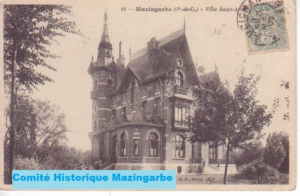Mazingarbe is located in Pas de Calais in northern France. It is approximately 60 miles from the coast at Calais.
Modern Map highlighting location of Mazingarbe in Pas de Calais, Northern France
On the eve of the World War I, Mazingarbe was mostly an agricultural village, with its buildings (farms, trading houses and craft workshops) built with chalk, bricks and clay cob. It also provided accommodation for local miners.
Image Courtesy of Comité Historique Mazingarbe
With the discovery of coal around the village, workers’ houses were built near mining pits 2, 3, 6 and 7 belonging to the Béthune Mining Company, and by 1911, the population had grown to 6,110 inhabitants.
On 15 January 1853, the Béthune Mining Company was awarded the Grenay concessions that covered an area of 5,761 hectares, (22.2 square miles). By 1859, the first mine shaft (designated 2) was opened in the neighbouring village of Bully-les- Mines. Pit 6 followed in 1876, then Pit 7 in 1877, both within the boundaries of Mazingarbe. Pit 3 opened on the Béthune–Lens Road. A local coal-processing plant had also been established by 1896.
The following map illustrates the distribution of the Company’s pits in the area around Mazingarbe before the outbreak of World War 1.
Attr: Eric Gaba, Wikimedia Commons user Sting
Fosse 7 – 7b Attr:Unknown author, Public domain, via Wikimedia Commons
Like Denbeath in Fife, where Robert lived after his marriage, housing (corons) was built to accommodate the new communities of mine workers, which also signalled the arrival of foreign workers. The first wave arrived from the Belgian mining area of Hainaut in Wallonia, on the border with northern France, who had been the victims of intolerance during periods of industrial unrest at the turn of the nineteenth and twentieth centuries.
The church was built in the middle of the nineteenth century using the ogival style of the thirteenth century. The ogival, or pointed, arch is a defining design element of Gothic architecture. and this style features magnificently in the church at Mazingarbe.
Image Courtesy of Comité Historique Mazingarbe
Mazingarbe had many grand buildings, e.g., Château Saint Arnold, that were to be used by British troops during periods such as the Battle of Loos.
